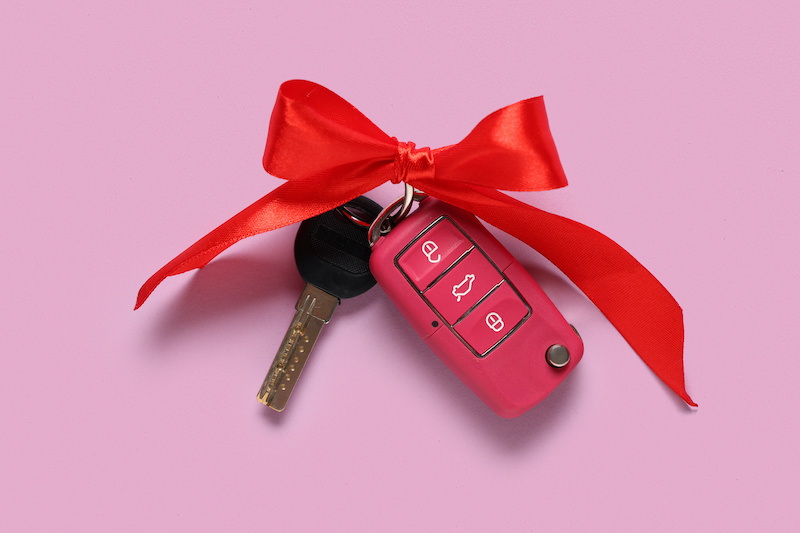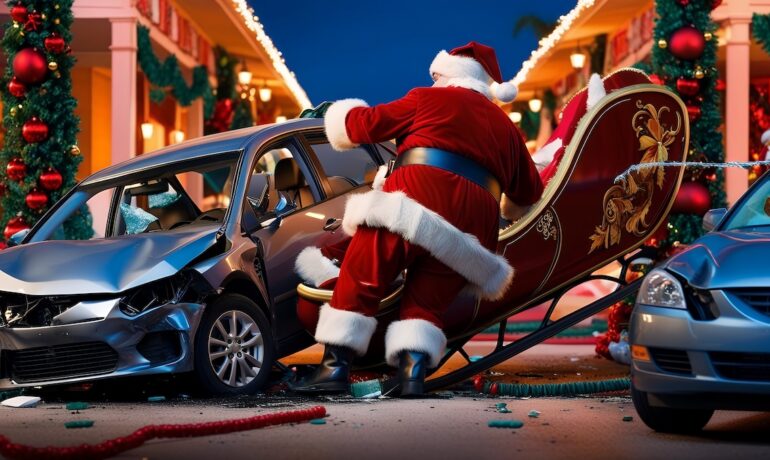 Oh, the weather outside is frightful. So, how do you keep your car safe as you drive this holiday season? People travel more between Thanksgiving and New Year’s than at any other time of the year. In fact, car accidents spike by 34% during the holidays, compared to regular days. This makes holiday season one of the riskiest times for drivers nationwide. Winter weather, packed roads, and holiday errands create a perfect storm of a holiday collision.
Oh, the weather outside is frightful. So, how do you keep your car safe as you drive this holiday season? People travel more between Thanksgiving and New Year’s than at any other time of the year. In fact, car accidents spike by 34% during the holidays, compared to regular days. This makes holiday season one of the riskiest times for drivers nationwide. Winter weather, packed roads, and holiday errands create a perfect storm of a holiday collision.
Safe holiday driving preparation could mean the difference between happy celebrations and an unfortunate event this year. We’ve put together tested safety tips to protect you and your family during holiday travel. You’ll learn practical ways to handle seasonal challenges with confidence – from basic vehicle maintenance to winter driving skills.
Pre-Holiday Collision Prevention– Vehicle Safety Checklist
A detailed safety check is the first step to get your vehicle ready for holiday travel. Studies show that proper vehicle maintenance can prevent up to 85% of winter-related breakdowns.
Smart Technology Updates and Checks to Prevent a Holiday Collision
 Your vehicle’s advanced driver assistance systems require extra attention before winter travel. Modern safety features like lane departure warnings and automatic emergency braking need proper calibration to work effectively in winter conditions. Check your vehicle’s monitoring systems. Some analyze facial features and driving patterns to alert you when attention is needed.
Your vehicle’s advanced driver assistance systems require extra attention before winter travel. Modern safety features like lane departure warnings and automatic emergency braking need proper calibration to work effectively in winter conditions. Check your vehicle’s monitoring systems. Some analyze facial features and driving patterns to alert you when attention is needed.
Winter-Specific Maintenance Points to Help Avoid a Holiday Collision
Your vehicle’s vital systems need extra care in cold weather. Batteries lose up to 35% of their strength below freezing, which means they must work harder for winter starts. Pay special attention to:
- Antifreeze levels and concentration
- Battery performance and connections
- Tire pressure and tread depth (minimum 4/32″ for winter driving)
- All exterior lights and replacement of dim bulbs
- Windshield wiper functionality and fluid levels
Emergency Kit Essentials for Holiday Travel Safety
A well-laid-out emergency kit can turn a dangerous situation into a minor delay. AAA suggests you pack:
- Cell phone charger and portable battery
- First aid supplies
- Flashlight with extra batteries
- Warning devices (flares or triangles)
- Simple toolkit with screwdrivers and pliers
- Drinking water and non-perishable snacks
- Blankets and warm clothing
- Ice scraper with brush
- Jumper cables
- Traction materials (sand, salt, or cat litter)
Note that monthly checks of your emergency supplies help you track and replace expired items. Your kit should be secured in your vehicle to prevent it from becoming a projectile during sudden stops.
 Strategic Holiday Travel Planning
Strategic Holiday Travel Planning
Smart planning substantially reduces holiday travel stress. Holiday traffic can increase travel times by up to 30% compared to regular days.
Best Times to Avoid Peak Traffic
Your departure timing is a vital part of your travel experience. Traffic peaks between 1 PM and 8 PM on days before major holidays. You can avoid congestion during these times:
- Before 10 AM on weekdays
- After 7 PM on weekends
- Actual holiday dates (Christmas Day, New Year’s Day)
- Early morning hours (before 8 AM)
Alternative Route Planning
Modern navigation tools give you powerful options beyond traditional route planning. Google Maps and Waze provide immediate traffic updates and alternative routes. Download offline maps and share your route with family members before you leave. Roads that parallel major highways often work better during peak congestion.
Holiday-Specific Driving Challenges
Holiday traffic presents unique seasonal challenges that demand extra attention. Cargo theft rises substantially during extended holiday weekends. The USA and Canada report losses of $19 million due to cargo theft.
Safely Transporting Gifts and Cargo
 Your holiday packages need proper placement in your vehicle to maximize safety. The life-blood items come first – heavy, stable packages should go as far forward as possible in your cargo area. To transport items securely:
Your holiday packages need proper placement in your vehicle to maximize safety. The life-blood items come first – heavy, stable packages should go as far forward as possible in your cargo area. To transport items securely:
- Stack items in tiers from left to right
- Place irregularly shaped items at the ends
- Keep emergency items readily available
- Avoid blocking rear visibility
- Secure all items to prevent movement
Navigating Decorated Areas Safely
Holiday decorations create unique visibility challenges. A safe distance of 10 feet from decorated areas with electrical displays ensures safety. Drivers should reduce speed in heavily decorated neighborhoods and watch for:
Increased pedestrian activity: Holiday shoppers and sightseers create unexpected foot traffic. Parking lot accidents make up 20% of holiday crashes. Extra watchfulness helps especially during evening hours with reduced visibility.
Safe arrival at your destination depends on your attention to these holiday challenges. Note that thieves target household goods and electronics during the holiday season. Keep valuable gifts out of sight while traveling.
Advanced Winter Driving Techniques
Winter weather leads to more than 156,000 auto accidents each year. Safe holiday travel depends on becoming skilled at advanced driving techniques.
Handling Black Ice and Snow to Avoid a Holiday Collision
Black ice typically appears at the time of early morning and evening hours, especially when you have bridges and overpasses. Here’s how to spot and handle black ice safely:
Look for glossy, smooth patches on otherwise dull road surfaces
- Watch for sudden vehicle swerving ahead
- Monitor areas with limited sunlight, especially bridges
- Stay alert to temperature changes near freezing point
Safe Following Distances to Reduce Your Risk of a Holiday Collision
 Winter roads need extra space between vehicles. Increase your following distance from 3-4 seconds to 5-6 seconds. Highway speeds require three to five car lengths between vehicles.
Winter roads need extra space between vehicles. Increase your following distance from 3-4 seconds to 5-6 seconds. Highway speeds require three to five car lengths between vehicles.
Hill navigation works better if you avoid stopping. Steady speeds come from gradual power application without wheel spin. Four-wheel drive vehicles help with acceleration but don’t improve stopping or steering on ice compared to regular vehicles.
Your skid response is a vital safety factor – steer gently toward your intended direction. Poor visibility in winter weather means you should find a safe spot to pull over and use shoulders only as a last resort.
Smart planning and defensive driving prevent most holiday accidents. These safety measures protect you, your family, and fellow travelers on the road. Safety should be your priority this holiday season. Those few extra minutes of preparation could save you from hours of trouble later.
About DG Collision Center, an Auto Body Shop in Covina, California
We would love to help restore your vehicle following a car accident or comprehensive damage. DG Collision Center in Covina, California is your one-stop-shop in Covina for auto body repair after car accidents. Our highly trained team includes specialized technicians. We work directly with all insurance companies. This enables our customers to file a claim without even needing to be present.




